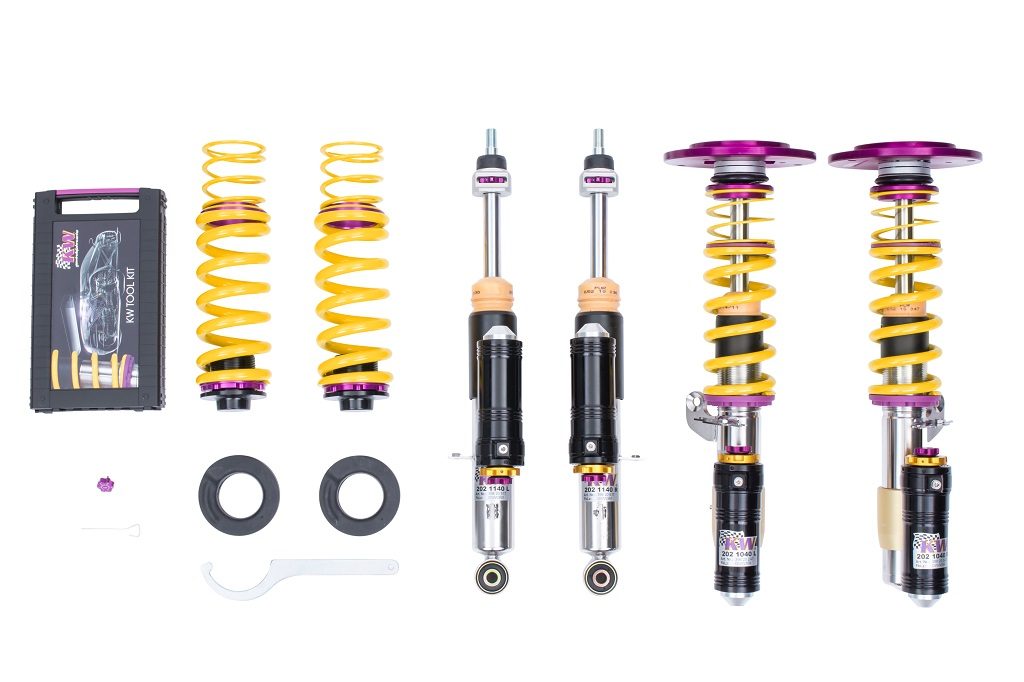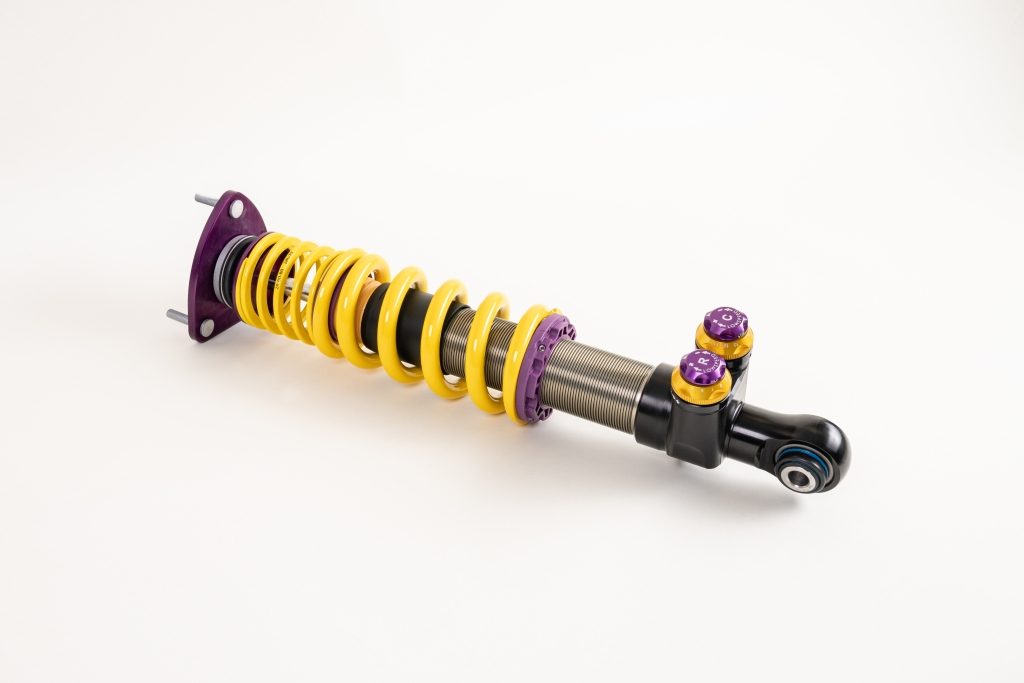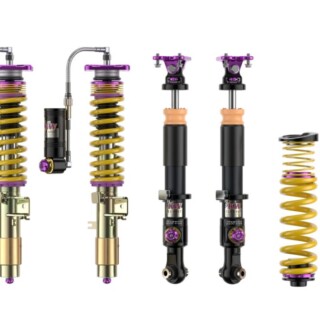
For the BMW M4 alone, we at KW offer six different suspension options with approved part certificates in our product categories “Street Comfort”, “Street Performance” and “Track Performance” in our product range!

In a positive sense, many people think we are crazy, while BMW-M enthusiasts love us for this massive product range.

Many people asking us what is the difference between the KW Coilover suspension kit Variant 4 and the KW Clubsport 3-way. That’s the reason why we took on our KW automotive Blog a closer look at these two suspension kits.
But to make sure that this doesn’t get too boring, there is a YouTube video from the “Nordschleife fan” and passionate Trackday driver Alex Hardt as a teaser (please activate the subtitles) in this blog post. In our feature, you will also find some more general basic information about the KW Clubsport 3-way and the Variant 4 and as well we will explain some myths about Coilover suspension kits. Have fun and take your time.

The difference between a KW Clubsport 3-way and a KW Variant 4

Let’s start with the obvious facts about the KW Clubsport 3-way and the KW Variant 4. Both Coilover suspension kits feature front axle struts and rear axle damper housing made of stainless steel.

At the first glance you see, the KW Clubsport (CS) 3-way and the KW Variant 4 (V4) Coilover suspension kit have adjustable top mounts on the front axle struts and a piggy pack. According to the technical parts report, both Coilover suspension kits has adjustable lowering range of 15 – 40 millimeters in the BMW M4 (equivalent to 65 millimeters of lowering on the BMW F32).

Our Clubsport 3-way and Variant 4 differ from conventional Coilover suspension kits with their 3-way adjustable shocks, partially hard-coated components made of aircraft aluminum alloys as well as special brass alloys, which guarantee excellent durability and maintenance free. On top of that, the alloy tube also ensured low surface friction in the working cylinder and reduce breakaway torque.

Basically they have similarities: The polymer spring perch, the trapezoidal threads, the rear axle height adjuster and the “yellow & purple” color…

If you take a closer look at the two front axle struts, you will see that in the Clubsport 3-way we use a two-part racing spring system. A linear preload spring (Helper Spring) and a linear suspension spring also known as mainspring.

Helper Spring 
Main Spring
The Helper Spring can be compressed together with one hand or both hands which depends on your own physical strength, because its function is keep the mainspring in place even if the wheel lost contact with the road surface for a split of a second due to fast rides or rough tarmac.

In Variant 4, on the other hand, we use a linear and longer mainspring without a preload spring. Actually, the word “preload spring” is rather the wrong term, since it is more of an “auxiliary spring” (Helper Spring) in road cars. The wildest rumors are by the way circulating on the subject of “preload”, more about this later in our “suspension myths”.

At the rear axle – the BMW M4 has a five-link axle – the suspension spring and damper are separated from each other. In the Clubsport 3-way and Variant 4, we use a two-part racing spring system with linear spring rates on the M4 rear axle.

Both suspensions have different spring rates and, despite their obvious similarities, such as the three-way adjustable dampers, they are completely different products and developed and tailor-made for a completely different purpose. After all, each suspension is always just a compromise, even if some marketing people like to tell you something different.

Whoever, like SJ Exclusive for example, regularly participates at trackdays with his street-legal BMW M4, should definitely choose a KW Clubsport 3-way Coilover suspension. That’s why we have developed the Clubsport suspension. Accordingly, the spring rates are also designed stiffer and the top mounts feature unibal bearings. The entire setup of the Clubsport 3-way is optimized for semi-slick sport tires and fast lap times.

On the other hand, we have developed our KW Variant 4 for all BMW M4 enthusiasts who simply want to drive more relaxed and harmoniously and sporty with road tires in everyday life, or who wish to be more flexible in terms of driving dynamics.

The KW Variant 4 basically resembles in its whole design and setup in a certain way our suspension, which we have developed in a similar design for our Customer BMW M for the BMW M4 GTS. And the V4 top mounts don’t feature unibal bearings; here we are using rubber bearings.

With the Variant 4 and the Clubsport 3-way, the valve unit is located in the piggyback (reservoir) for independent adjustment of the low-speed and high-speed compression stage forces. This is mounted directly on the damper housing or the front axle on the suspension strut.

Our valve technology, which is separately adjustable in the low-speed and high-speed compression forces of the compression stage damping, is called “KW TVCLH-A” (Twin Valve Compression Low-/Highspeed Adjustable). High-speed and low-speed, by the way, means the piston rod speed. Unfortunately, it cannot be said in general that the high-speed range starts at about 0.2 m/s, as this depends on the damper construction.

With the compression stage dampening in the shock, the suspension spring is supported during compression, which also allows a more comfortable spring constant (spring rate) to be used. This is because the damper already absorbs some of the impact energy, which means that the spring basically has to absorb less energy. The compression stage also supports the body structure.

Via the purple-colored adjustment wheel, you turn the brass-colored “low-speed spindle” in the valve, which has different bores through which the damper fluid or damper oil can flow. Over the large golden wheel, the high-speed pressure stage is tuned.
With the adjustable low-speed compression stage, you have control on the body roll when turning in and on the pitching behavior when braking and accelerating. The damping can also be influenced by the low-speed in case of long bumps. The high-speed compression stage, on the other hand, helps you to dampen small potholes, short bumps, cross grooves, joints and the like. And of course, the valving of the KW Clubsport 3-way and the Variant 4 differ in their design, material thickness and spring rates.

Also, the rebound stage of our KW Coilover suspension kits is already built up with our two-stage valve technology (TVR-A, Twin Valve Rebound Adjustable – Technology) from the Variant 2 on. With the Clubsport 3-way and the Variant 4, the rebound forces can be adjusted and fine-tuned with 16 clicks in the low-speed range.


lateral cut of the rebound valve
The spiral valve spring is used to build up the high-speed rebound stage. The low-speed rebound is determined by the bypass disc and the adjusting rod. With the rebound click setting, you can open or close a bypass channel in the valve with 16 clicks and can thus influence, for example, how fast the suspension rebounds in the deflected state when load changes happen.

The rebound stage can also be described in the way the car body is connected to the road. In Variant 4 and the Clubsport 3-way, the rebound valve design naturally differs in spring rates, material thickness and so on.

KW Variant 4 is always delivered with our basic and pre-dialed performance setting. Compared to the KW Clubsport 3-way, the Variant 4 is more of an “all-rounder” in everyday use and despite the “BMW M4 GTS genes”, a V4 and even the suspension we developed for the M4 GTS do not quite come close to the performance of a KW Clubsport 3-way Coilover suspension, as the entire design of the Clubsport suspension is optimized for race track use with street-legal cars. Variant 4, on the other hand, offers the option of either tuning the M4 in a sporty Gran Turismo or turning it into an occasional grassroots trackday car.
How a Variant 4 drives in the BMW M4, Alex Hardt tells you in his second video …
Too stiff, or not too stiff, that is sometimes a myth …

Sure, we can also smile about the famous German “KW-MEME” from our fans (Nothing is tougher as a divorce, except a KW Coilover Suspension kit Variant 3), but as every Nordschleife and trackday enthusiast knows, the MEME does not show a V3 Coilover suspension, but an old KW Competition Racing kit… Apparently, the MEME is due to the myth that the number behind our product names should always indicate the stiffness of our KW Coilover suspensions.

But what is stiff at a suspension? Giving you a satisfiable and objective answer is not so easy. Because often the perceived stiffness is felt purely subjectively. On the other hand, not only the shock setup, the spring rate and the spring travel influence the ride comfort, but also the tires and the whole unsprung masses.

When talking about ride comfort, it is often forgotten that the axle kinematics and axial elasto-kinematics have just as great an influence on ride comfort as the tires, dampers, and springs. Have you ever thought about all the rubber-metal elements in the wishbone bearings and so on?

Our R&D philosophy for KW Coilover suspensions, especially our KW Coilover suspension kits from our “Street Performance” category, can best be described as we always design a suspension kit as stiff as necessary and as comfortable as possible for everyday use.

But back to the “KW MEME” and the myth that a KW Variant 1 is less stiff than a Variant 2. The digit “1” on the KW Coilover suspension Variant 1 simply means that the suspension has one adjustment option: the continuously variable lowering. With Variant 2 there are already two adjustment options: Lowering and rebound adjustment (two-stage valve technology TVR-A, Twin Valve Rebound Adjustable). Variant 3 has three adjustment parameters: separate adjustment of the compression (two-stage valve technology TVC-A, Twin Valve Compression Adjustable) and rebound (two-stage valve technology TVR-A, Twin Valve Rebound Adjustable) forces as well as lowering the vehicle …

Myths, half-knowledge and hard-parking legends
In some forums, you are always read the most amazing things about suspension kits and not just about ours. For example, according to many “keyboard engineers”, changing the lowering will change the spring preload and spring rate. According to the motto, the lower you get, the stiffer the spring rate will be.

This is only partly true and is more likely to be the case when trying to achieve a supposed maximum lowering with a conventional lowering spring set and the M4 standard struts and shocks. So, there are in the market lowering springs which allow a lowering of 30 millimeters or more on the F82. But since the length of the damper does not change, the optimal working range and spring travel of the OEM damper are massively impaired.

You must never forget that the springs actually bear the weight of the car and that the damping must also work with a maximum load with four passengers and your suitcases in the trunk.

Many spring manufacturers, therefore, use a much higher spring constant, also known as spring rate, so that the shorter lowering springs do not go on block (or get compressed simply because of the vehicle weight). After all, the shorter spring length has also reduced the spring travel. In this way, spring manufacturer is trying to prevent the spring from constantly hitting the original bump stop or through the reduced spring travel basically only the bump stop is trying to work as a spring.

If you think that you can only drive a sporty car with a spring set and a lowering of 30 millimeters in combination with the standard suspension, you have to be a very tough guy. In this case, it’s really impossible to speak of real driving dynamics. Or, to put it drastically, if the M4 is excessively lowered by only lowering springs in conjunction with the standard suspension, you will limit your well-engineered and fine Bavarian performance car and turn it in a soapbox with a motor. Even the optional adaptive M dampers can no longer help and the M4 then will perform in the driving dynamic limit on topspeeds like a car without any suspension at all.

Stiff springs or too high spring constants lead to a high body frequency and have the advantage that the vehicle moves less when loaded. In corners the body tilts less. But the driving comfort diminishes a little and the M4 loses grip if the spring rates are too stiff. You need to find the perfect compromise or on the other hand, trust your MIT engineers.

This is also one of the reasons why, for example, our height-adjustable springs for the BMW M4 “only” allow a lowering of 25 millimeters. And even these 25 millimeters only work because we also supply special elastomer spring elements and dust protection caps for the height-adjustable spring set. This means that even during overly dynamic driving maneuvers there are still reserves and the standard dampers can do their job.

But before the interjection that we as KW automotive also offer ST suspensions lowering springs for the M4, we would like to mention that these springs allow a lowering of 20 millimeters on the front axle and 15 millimeters on the drive axle. If you want to go lower, you should then prefer a Coilover suspension or a set of height adjustable springs if you only look for decent lowering.
Lowering allegedly affects the preload and spring rate
But also for Coilover suspension kits, the myth that lowering will affect the spring preload or changes the spring rate when turning the spring plate down, the stiffer spring rate will get. The internet wisdom is really strange, too many try to act as an expert or believing the marketing blah blah blah blah.

Also here it is a little bit different than you can read in some forums. Because the struts and damper housings of a KW Coilover suspension kit are already shorter compared to the series components, the spring travel can be up to 10 millimeters longer than on the series suspension strut despite lowering.

In addition, all aspects of our KW Coilover suspension kits, from spring rate, spring length to spring travel and damper construction, are designed for the lowering and the respective vehicle as specified in the parts report. For example, the KW Variant 4 and the KW Clubsport 3-way already provides a minimum lowering of 15 millimeters by installation in the M4 alone.

According to the parts report, the M4 body can be lowered by a further 25 millimeters to a maximum lowering of 40 millimeters via the trapezoidal thread on the suspension strut and rear axle height adjuster. This corresponds to a lowering of 65 millimeters on the front axle and 60 millimeters on the rear axle of a normal BMW 4-series Coupé (F32).

In the tested, checked and approved area the damping works perfectly, and the spring rate does not change at all. Also, we have tested and checked everything at this maximum lowering covered by the parts report, so that no damage can occur to axle joints, coupling rods, track rods, driveshafts, brake lines, etc. when installing correctly.

Besides, meticulous care is taken to ensure that the wheels have free movement and that the parts located on the underbody, such as the oil pan, axle or exhaust, do not strike even under extreme loads on the road. During installation, however, the wheel clearance should always be checked once in all respects, as there are certain tolerances with many car bodies.

Even if you think that you have to exhaust the production-related residual thread in order to drive in the “ultra-super stance mode of the residual thread”, this does not change the spring rate. But the performance of the suspension massively reduced by the much too short spring travel or working travel of the piston rod. The parts certificate, as well as the KW warranty, will expire.
Back to the spring rate

But back to the myth that by changing the lowering, the spring preload, as well as the spring rate, also changes, we have to go back a little further. The job of the springs in a car is basically to carry the weight of the vehicle and besides that, they also have the job of positioning the body at a certain height so that the compression travel is in a sufficient ratio to each other.
The occurring shocks from the deflecting wheels and unsprung masses are absorbed by the springs. According to the good old school knowledge, every sprung mass has a natural frequency, which sometimes gets into resonance just by an impact during compression in such a way that it follows its own oscillation pattern. The suspension spring would cause an uncontrolled rocking of the car. To prevent this from happening, there are dampers. Basically, a spring stores the “impact energy” created during compression and tries to dissipate it by rebounding. The shock absorbers, also known as shock vibration dampers, control the release of the spring. Within a certain window, the spring and damper must always be optimally matched.

The spring rate or spring constant (R) of a cylindrical coil spring is calculated by the material thickness (wire thickness, wire diameter, d4), the number of coils (n) and the mean coil diameter ( D³) as well as shear modulus/sliding constant (G) of the spring alloy used. The formula can usually be found in your old physics schoolbooks.

Or, as a colleague once put it so aptly: Changing the vehicle depth changes the spring preload and thus the spring rate is fundamentally wrong! His illustrative thought experiment was that you don’t get heavier or lighter if you put an office chair on a scale, sit on it and changing the height of the office chair.

On the upper picture, you can see the KW Coilover suspension Variant 4 front axle strut and with an eased spring. If the suspension is installed, the suspension spring would be a few millimeters compressed by the vehicle weight alone.

The spring rate simply indicates how many Newton (N) a force must act on a spring to compress it by one millimeter.

The spring preload does not change at the standing height of the M4, whether you turn the spring perch down or up. The preload can only be influenced by changes in the weight of the vehicle because a suspension spring carries the body.

The picture above is a Variant 3 for an Audi S4 with an “apparently stance residual thread”. Before you raise your hopes; you cannot screw the spring plate down to the last thread, because then the strut would not fit into the wheel arch. The fact that the thread has so much room for maneuver is only due to the production process in our mechanical production.
Back to the crucial question: Which Coilover suspension kit you should opt for your BMW M4?

That depends on yourself. Do you drive your BMW M4 on public roads 95 percent of the time in everyday life and want it to be a little more sporty: As a KW Variant 3 or, if you want to continue using your electronic damper control, the adaptive KW DDC plug&play Coilover suspension is the best investment for everyday use.
If you want a little bit more and your BMW M4 should show the performance of a BMW M4 GTS in everyday life and on occasional trips to the racetrack: there is no way around the KW Variant 4.
If the Nürburgring Nordschleife or any other racetrack is the second home of your BMW M4 and you participate at numerous trackdays, there is only one suspension for your M: the KW Clubsport 3-way.
Photo Archive (KW, BMW, TVW, SJ Exclusive, EAS, Aleko Photography), YouTube, (BMW, NationalGeographics, Alex Hardt, that_nurburgring_guy); Words C. Schmidt










